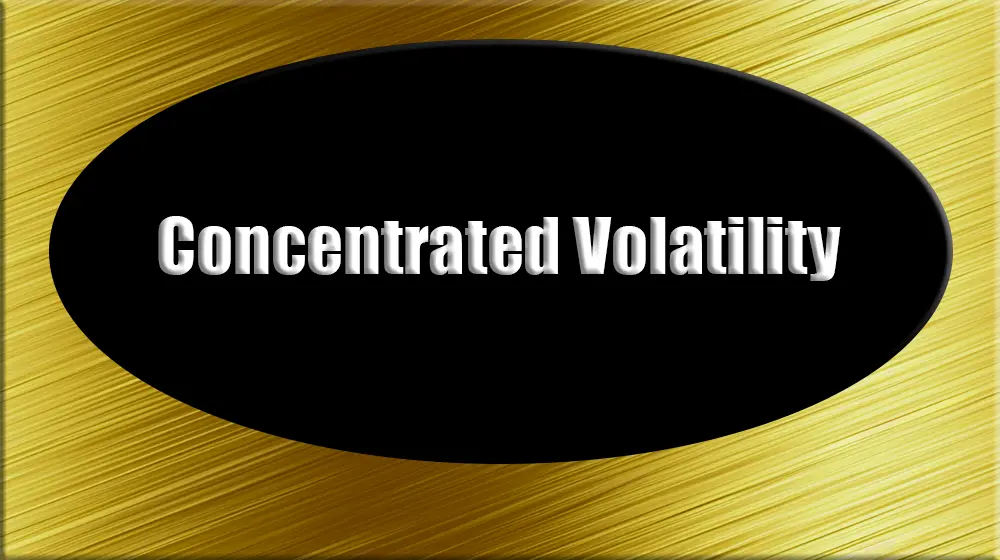In decentralized finance (DeFi), the term \”concentrated volatility\” refers to a scenario where large price movements are focused in specific areas or assets within the broader DeFi ecosystem. This phenomenon is particularly relevant in the context of liquidity pools and automated market makers (AMMs), which are foundational components of DeFi.
Concentrated volatility arises when significant trading activity, whether buying or selling, is centered on a particular token or pool. This can lead to substantial price swings that are not as evident in other parts of the market. For example, a sudden surge in demand for a particular token due to a new protocol update or partnership can cause its price to skyrocket, influencing the liquidity pool\’s balance and potentially leading to temporary price inefficiencies.
This type of volatility is a critical consideration for liquidity providers and traders. For liquidity providers, concentrated volatility can affect the value of their staked assets, exposing them to temporary loss, especially if the market does not correct quickly. For traders, these conditions can present both opportunities and risks; rapid price changes can lead to significant gains, but also to equally significant losses.
Managing the risks associated with concentrated volatility involves strategies like diversification of investment across different pools, active management of one\’s investment positions, and the use of financial instruments such as options for hedging. Awareness and understanding of the specific market dynamics of each DeFi protocol are also crucial, as each protocol may have unique features that affect how volatility manifests.
Overall, concentrated volatility in DeFi is a double-edged sword that requires sophisticated strategies and keen market insight to navigate effectively, highlighting the dynamic and often unpredictable nature of this emerging financial landscape.
Managing risks associated with concentrated volatility in decentralized finance (DeFi) involves several strategic approaches that can mitigate potential losses and capitalize on opportunities. Concentrated volatility refers to sharp and localized price movements in specific assets or liquidity pools, which can dramatically affect the value of investments. Here are some key strategies used by participants in the DeFi ecosystem to manage these risks:
- Diversification:
- Diversification is a key strategy in DeFi, similar to traditional financial markets, because it helps mitigate the risk inherent in investments. In DeFi, diversification isn\’t just about spreading investments across multiple cryptocurrencies but also involves different DeFi protocols and financial products.
- The fundamental premise behind diversification in any investment scenario, including DeFi, is to reduce the impact of volatility on the entire portfolio. Since the prices of different assets can vary widely and independently, diversifying helps ensure that a sharp decline in one asset doesn\’t lead to an overall portfolio collapse. This principle is particularly pertinent in the DeFi space, which is known for its high volatility compared to traditional markets.
- In DeFi, diversification can be approached in several ways. One method is through asset diversification, where investments are spread across various types of digital assets such as different cryptocurrencies, stablecoins, and DeFi tokens. Each type of asset has different characteristics and reacts differently to market changes. For instance, while major cryptocurrencies like Bitcoin and Ethereum may experience significant price fluctuations, stablecoins like USDC or Dai can offer stability as they are pegged to traditional currencies.
- Another strategy is protocol diversification, where investments are distributed across various DeFi platforms. This is crucial because it reduces exposure to risks associated with individual protocols, such as smart contract vulnerabilities or administrative failures. With the rise of insurance protocols within the DeFi ecosystem, such as those provided by Neptune Mutual, there\’s an added layer of security that helps manage these risks by offering coverage against specific types of failures in DeFi projects.
- Moreover, diversification by industry or geography can further protect investors from region-specific regulations or industry-specific downturns. By investing in DeFi projects that operate in different sectors or regions, an investor can mitigate the risk of adverse effects from a single sector or regulatory environment.
- Finally, time diversification, also known as dollar-cost averaging, involves spreading the investment across different time periods to reduce the risk of entering the market at an unfavorable time. This strategy can be particularly effective in highly volatile environments like DeFi by smoothing out the purchase price over time.
- In essence, while diversification cannot eliminate all risks, it plays a crucial role in managing and minimizing potential losses in the DeFi space. As the market matures, the importance of sophisticated diversification strategies will likely become more pronounced, helping investors navigate this evolving landscape more safely.
- Liquidity Provision Management:
- For liquidity providers (LPs) in the decentralized finance (DeFi) space, managing contributions to liquidity pools requires strategic consideration to optimize returns and minimize risks. Key factors that should influence their decisions include the size of the pool, the nature of the underlying assets, historical stability, and susceptibility to sudden price changes. Here are several best practices and strategic considerations for liquidity provision in DeFi:
- Choosing the Right Pools: LPs should select pools based on factors like asset volatility and pool size. Pools with high-volume trading and low volatility in underlying assets generally present fewer risks of impermanent loss, a common risk where the value of deposited assets changes compared to when they were deposited (Unvest.io).
- Diversification: Diversification across different pools can help manage risks. By not allocating all capital into a single pool, LPs can reduce potential losses from one pool\’s poor performance (Unvest.io, Coinweb.com).
- Dynamic Approaches: LPs can benefit from adopting dynamic strategies, such as adjusting their stake in response to market conditions or utilizing automated strategies to reinvest dividends for compounding returns (Unvest.io).
- Understanding Fees and Rewards: Different pools offer varying fee structures and rewards. LPs should understand how fees are distributed, the potential yields from liquidity mining, and any additional incentives such as governance tokens or staking rewards (SmartCredit.io, BeInCrypto.com).
- Technology and Innovation: Keeping up with technological advancements in the DeFi space can also offer advantages. For example, innovations like Uniswap V3 introduce concentrated liquidity, allowing LPs to allocate funds within specific price ranges, potentially increasing fee earnings and reducing capital requirements (Datawallet.com).
- Monitoring and Adjusting: LPs should continuously monitor their investments and adjust their strategies in response to changes in the market or the performance of their pools. This includes being aware of major updates or shifts in the protocols they are using (BeInCrypto.com, SmartCredit.io).
- By carefully considering these factors and staying informed about the latest developments and best practices in DeFi, liquidity providers can more effectively manage their investments and mitigate risks associated with liquidity provision.
- For liquidity providers (LPs) in the decentralized finance (DeFi) space, managing contributions to liquidity pools requires strategic consideration to optimize returns and minimize risks. Key factors that should influence their decisions include the size of the pool, the nature of the underlying assets, historical stability, and susceptibility to sudden price changes. Here are several best practices and strategic considerations for liquidity provision in DeFi:
- Hedging:
- In DeFi, hedging is a crucial risk management strategy that often utilizes derivative instruments such as options and futures. These tools allow traders to protect against potential losses from adverse price movements or to speculate on future price changes of digital assets.
- Options, especially put options, are widely used for hedging. A put option grants the holder the right to sell an underlying asset at a predetermined price within a specific timeframe, providing a safety net against price declines. If the market price of the asset drops below this strike price, the option holder can still sell at the higher agreed-upon price, thereby minimizing losses.
- Futures contracts are another common hedging tool in DeFi. These contracts involve an agreement to buy or sell an asset at a future date at a price fixed at the time of the contract. Unlike traditional futures, which often require the physical delivery of the asset upon expiration, many DeFi platforms offer perpetual futures that do not expire, allowing for continuous price management.
- While derivatives provide significant opportunities for hedging and speculating in DeFi, they also come with risks such as liquidity constraints, regulatory uncertainties, and the complexities of managing derivative positions in a decentralized setting. Traders using these instruments must have a robust understanding of both the tools and the market dynamics to effectively manage risks while exploring potential returns.
- Stop-Loss and Take-Profit Orders:
- Implementing automated trading strategies like stop-loss and take-profit orders is a practical way to manage exposure to market volatility. These tools are designed to execute trades automatically when certain predetermined price levels are reached, providing crucial risk management benefits:
- Stop-Loss Orders: These orders trigger a sale of your asset when its price drops to a specified level. This mechanism helps to cap potential losses by exiting a position before prices fall further.
- Take-Profit Orders: Conversely, take-profit orders execute a sale when the asset price reaches a certain level on the upside. This ensures that profits are secured by selling before potential price retracements.
- These trading tools are essential in helping investors protect gains and limit losses without needing to monitor their portfolios constantly. They are especially useful in fast-moving and unpredictable markets, allowing traders to set their maximum loss and desired profit levels in advance. This automated approach can help maintain discipline in trading strategies, removing emotional decision-making from the process of selling or buying assets.
- Implementing automated trading strategies like stop-loss and take-profit orders is a practical way to manage exposure to market volatility. These tools are designed to execute trades automatically when certain predetermined price levels are reached, providing crucial risk management benefits:
- Risk Assessment Tools:
- Utilizing various risk assessment tools and analytics platforms is crucial for gaining a deeper understanding of market trends and asset correlations. These tools leverage both historical data and real-time inputs to provide forecasts of potential price movements, which can significantly enhance decision-making processes.
- Historical Data Analysis: By examining past market behavior, these tools can identify patterns and trends that are likely to repeat. This analysis helps investors anticipate moves and make informed decisions based on proven market cycles and outcomes.
- Real-Time Data Insights: Modern risk assessment platforms integrate real-time data, allowing traders to react quickly to market changes. This immediate data is crucial during volatile market conditions, where prices can change rapidly.
- Predictive Analytics: Advanced analytics involve predictive models that use existing data to forecast future market behaviors. These predictions can be based on a variety of statistical and machine learning techniques.
- Correlation Analysis: Understanding how different assets interact with each other can help in diversifying portfolios and managing risk. Analytics platforms can highlight these correlations, showing how certain assets move in relation to others during different market conditions.
- These tools provide robust insights that help traders and investors make more informed, strategic decisions, potentially leading to improved investment outcomes. They are essential for anyone looking to enhance their trading strategies and risk management capabilities in the fast-paced financial markets.
- Utilizing various risk assessment tools and analytics platforms is crucial for gaining a deeper understanding of market trends and asset correlations. These tools leverage both historical data and real-time inputs to provide forecasts of potential price movements, which can significantly enhance decision-making processes.
- Active Portfolio Management:
- Active management in investment, particularly in dynamic environments like DeFi or traditional stock markets, involves a strategic and ongoing process of monitoring and adjusting the asset allocation within one\’s portfolio. This proactive approach is essential in responding effectively to market volatility and evolving investment opportunities. Here\’s how it typically works:
- Portfolio Rebalancing: This is a core strategy where investors periodically adjust their portfolio\’s asset mix back to its target allocation. This could mean selling off assets that have grown to constitute too large a portion of the portfolio and buying more of those that have shrunk, thus maintaining a balanced risk exposure as per the original investment strategy.
- Risk Management: Active management allows investors to shift their holdings between assets or pools based on perceived risk and potential return. For instance, moving investments from high-risk to lower-risk pools can protect the portfolio against unforeseen market downturns, especially when the market shows signs of increased volatility or when certain assets become overvalued.
- Adaptation to Market Changes: Active managers continuously assess market conditions and adjust investment strategies accordingly. This might include increasing exposure to assets expected to outperform in coming market phases or reducing exposure to those expected to decline.
- Use of Advanced Tools: Active managers often utilize financial tools and models to predict market trends, assess risk, and optimize portfolio performance. These tools can include quantitative models, fundamental analysis, and technical analysis charts.
- Active management is labor-intensive and requires a deep understanding of market mechanisms and the factors influencing asset prices. It contrasts with passive management, where investors typically buy and hold a diversified mix of assets without frequent adjustments, relying on market exposure for returns. Active management aims to outperform benchmark returns by taking advantage of market inefficiencies and timing, making it suitable for investors who believe markets are not always efficient and prefer a hands-on investment approach.
- Active management in investment, particularly in dynamic environments like DeFi or traditional stock markets, involves a strategic and ongoing process of monitoring and adjusting the asset allocation within one\’s portfolio. This proactive approach is essential in responding effectively to market volatility and evolving investment opportunities. Here\’s how it typically works:
- Education and Research:
- Continuously educating oneself about the latest developments, innovations, and risks in the DeFi space is essential for staying competitive and effective in managing investments. The DeFi sector is rapidly evolving, with new protocols, tools, and strategies emerging regularly, which can significantly impact market dynamics and investment outcomes.
- Staying Updated with Market Developments: The DeFi landscape is characterized by rapid technological advancements and regulatory updates. Regularly following reputable financial news sources, DeFi platforms, and industry blogs can provide timely insights into these changes.
- Leveraging Educational Resources: Numerous online platforms offer courses and tutorials that cover a wide range of topics from basic blockchain technology to advanced DeFi strategies. Engaging with these resources can deepen understanding and enhance decision-making skills.
- Participating in Community Discussions: Engaging with community forums and social media groups focused on DeFi can provide real-time insights and help gauge market sentiment. Discussions with other investors and experts can also expose one to diverse perspectives and new ideas.
- Experimenting with New Tools: As new tools and platforms are developed, experimenting with them in a controlled environment (e.g., using testnets) can provide a hands-on understanding of their potential impact and usability.
- Attending Conferences and Webinars: These events are valuable for connecting with thought leaders and innovators in the DeFi space. They often provide advanced knowledge and early warnings about potential risks and opportunities.
- By maintaining an active role in education and community engagement, investors can better navigate the complexities of the DeFi market and adapt more effectively to changes, ensuring more robust and informed investment strategies.
- Continuously educating oneself about the latest developments, innovations, and risks in the DeFi space is essential for staying competitive and effective in managing investments. The DeFi sector is rapidly evolving, with new protocols, tools, and strategies emerging regularly, which can significantly impact market dynamics and investment outcomes.
- Community and Expert Insights:
- Engaging with community discussions and seeking insights from industry experts are invaluable strategies for navigating the often volatile DeFi market. Many DeFi communities are highly active on platforms like Reddit, Discord, and Telegram, where participants share knowledge, experiences, and strategies, contributing to a richer understanding of the market dynamics.
- Learning from Varied Perspectives: DeFi forums and social media platforms host a wide array of viewpoints from people around the world. This diversity in thought and experience can provide multiple approaches to managing investments and understanding market movements.
- Real-Time Updates and Tips: These communities often share real-time updates on market changes, upcoming events, or shifts in protocol policies that might not be immediately available through traditional news channels. Tips and strategies shared by experienced members can be particularly valuable during periods of high volatility.
- Collaborative Problem Solving: Community members often collaborate to solve problems or to provide technical support. Engaging with these groups can lead to quicker resolutions of issues that individual investors might face with DeFi platforms.
- Networking Opportunities: Regular interaction with other DeFi enthusiasts can lead to networking opportunities that might translate into collaborative projects or partnerships. It also allows newer participants to learn from seasoned investors and developers.
- Feedback and Validation: Presenting one’s own strategies and ideas and getting feedback from the community can be a robust way to validate and refine investment approaches. Critical and supportive feedback can help in fine-tuning strategies to better manage risks associated with DeFi investments.
- Active participation in these communities not only enhances one\’s knowledge and skills but also helps in staying updated with the latest DeFi trends and technologies, making it a critical practice for anyone serious about DeFi investment.
- Engaging with community discussions and seeking insights from industry experts are invaluable strategies for navigating the often volatile DeFi market. Many DeFi communities are highly active on platforms like Reddit, Discord, and Telegram, where participants share knowledge, experiences, and strategies, contributing to a richer understanding of the market dynamics.
By employing these strategies, participants in the DeFi ecosystem can better manage the risks associated with concentrated volatility, enhancing their ability to achieve stable returns while minimizing potential losses.




